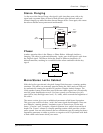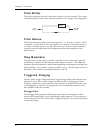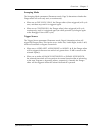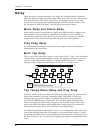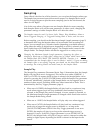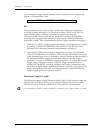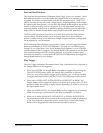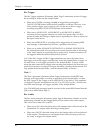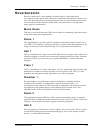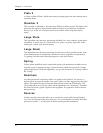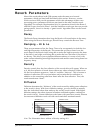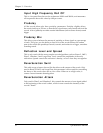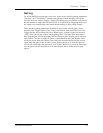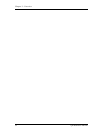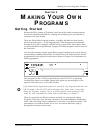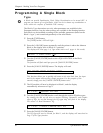
Overview - Chapter 3
Q20 Reference Manual 49
Reverberation
Reverb is made up of a large number of distinct echoes, called reflections.
In a natural acoustic space, each reflectionÕs amplitude and brightness decays over
time. This decaying action is influenced by the room size, the location of the sound
source in the room, the hardness of the walls, and other factors. The Q20 offers
many types of reverberation:
Mono Room
This uses a very small amount of DSP and is useful for combining with other effects,
or for dual-mono reverb applications.
Room 1
This algorithm gives you the sound of a medium sized studio room. It doesnÕt use a
lot of DSP, so itÕs useful for placing at the end of a guitar multi effect program or for
using 2 reverbs at once for dual processing. Try it on percussion and brass, too.
Hall 1
This is a simulation of a large concert hall. Halls tend to be large rooms with lots of
reflective surfaces, so sounds can swim around, changing timbre over time. It doesnÕt
need a lot of DSP, so you can use it on a guitar multi effect or a dual reverb send
program.
Plate 1
This is a simulation of a classic echo plate, a 4' by 8' suspended sheet of metal with
transducers at either end used to produce reverb. Popular in the 1970Õs, it is still
prized for its transparent sound, particularly on vocals and guitars.
Chamber 1
Reverb chambers are small rooms made of the hardest, smoothest surfaces
available (often marble). A loudspeaker is placed at one end, and 1 or 2
microphones at the other end. The decay time is adjusted by the distance from the
microphones to the speaker and by sound diffusers placed in the room. This
algorithm works well for keyboards and acoustic instruments.
Room 2
This algorithm uses more DSP for a richer sound and smoother decay. It compares
quite favorably to high end studio reverbs for its rich sound. The attack is also more
reflective. It sounds good on drums, organs, keyboards and guitars.
Hall 2
More processing is dedicated for a more realistic, airy concert hall. This is a classic
reverb which sounds good on just about anything; try it on vocals, drums, acoustic,
electric, or orchestral instruments.



